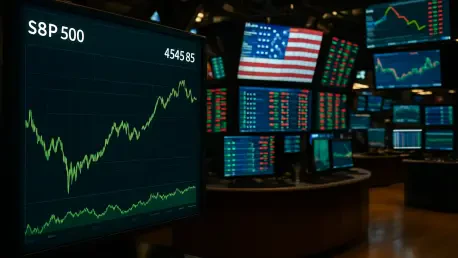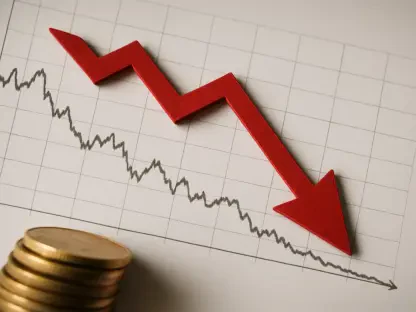The U.S. stock market encountered a turbulent session on a recent Tuesday, with major indexes like the S&P 500, Dow Jones Industrial Average, and Nasdaq Composite all slipping into negative territory, reflecting deeper anxieties about the nation’s economic health. A wave of discouraging data, particularly from services industries such as transportation and retail, has heightened fears of a slowdown, shaking investor confidence at a time when stability is desperately sought. This downturn isn’t merely a numbers game; it represents the tangible struggles of businesses grappling with rising costs and uncertain futures. Beyond the raw data, corporate earnings have painted a fragmented picture, with some sectors floundering while others, notably technology and AI, offer a beacon of resilience. Meanwhile, trade policies and geopolitical frictions add layers of complexity, as does the anticipation of Federal Reserve actions. Together, these elements weave an intricate narrative of a market caught between challenges and cautious optimism, urging a closer look at the forces at play.
Economic Indicators and Market Performance
Economic Slowdown Signals
A significant factor behind the recent dip in U.S. stock indexes is the troubling economic data emerging from key sectors. The Institute for Supply Management recently reported a noticeable decline in business activity within services industries, which are often seen as bellwethers for broader economic vitality. This slowdown, evident in areas like transportation and retail, has sent ripples through Wall Street, as it suggests that the economy may be losing steam at a critical juncture. Investors, already on edge due to mixed signals in other areas, are interpreting this data as a warning sign that growth could falter further if conditions do not improve. The impact is not just numerical but psychological, as market participants recalibrate their expectations for corporate performance and consumer spending in the coming months, bracing for potential headwinds that could deepen the current downturn.
Compounding this unease is the realization that such economic indicators are not isolated incidents but part of a broader pattern of softening activity. Unlike previous quarters where temporary dips were often offset by robust recovery signals, the current data lacks the accompanying optimism that might temper investor fears. Businesses in the affected sectors are reporting reduced orders and slower growth, which directly correlates with diminished stock valuations as confidence wanes. This situation is particularly concerning for industries reliant on consumer discretionary spending, where even slight economic contractions can lead to outsized impacts on revenue. As a result, the market’s reaction, while seemingly sharp, mirrors a growing consensus that these signals could herald a more prolonged period of economic uncertainty unless corrective measures are swiftly implemented.
Corporate Earnings: A Mixed Bag
Corporate earnings reports have emerged as a pivotal element in shaping the current market landscape, revealing stark contrasts across industries. On one hand, several companies have faced steep declines in stock value after posting disappointing profits and revenues, with firms in traditional sectors bearing the brunt of economic pressures. These lackluster results often stem from weakened consumer demand and operational challenges that have eroded profit margins. Such outcomes have fueled bearish sentiment among investors, who are quick to penalize underperformance in an environment already fraught with uncertainty. The sharp drops in stock prices for these companies underscore how vulnerable certain sectors remain to even minor economic hiccups, amplifying concerns about the durability of market stability.
In stark contrast, the technology and AI sectors are providing a much-needed counterbalance with impressive gains that defy the broader downturn. Companies in these innovative fields have reported earnings that not only exceed expectations but also signal robust future growth through raised revenue forecasts. This resilience highlights growing investor confidence in technology as a driver of long-term value, even when other parts of the economy falter. Unlike their struggling counterparts, these firms benefit from strong demand for cutting-edge solutions and digital transformation, positioning them as outliers in a market otherwise weighed down by pessimism. Their success stories serve as a reminder that innovation can thrive amidst adversity, offering a sliver of hope that not all sectors are equally battered by the current economic climate.
Trade Policies and Business Challenges
Tariff Troubles Weigh on Businesses
Trade policies, particularly the imposition of tariffs, have become a persistent source of frustration for many U.S. businesses, significantly contributing to the recent market decline. Across industries such as healthcare and real estate, companies are reporting substantial increases in operational costs directly tied to these trade barriers, which often force difficult choices between absorbing expenses or passing them on to consumers. Project delays have become commonplace as firms hesitate to commit resources amid such uncertainty, further hampering growth prospects. This pervasive impact is not merely anecdotal but is reflected in declining profit margins and cautious forward-looking statements from corporate leaders, painting a picture of an economy strained by policy-induced friction that shows little sign of abating in the near term.
The ripple effects of tariffs extend beyond immediate financial burdens, creating a climate of unpredictability that stifles long-term planning. Businesses are finding it challenging to forecast costs or secure supply chains when trade policies remain in flux, leading to a broader erosion of confidence that permeates investor sentiment as well. While some companies have attempted to mitigate these effects through strategic adjustments, such as diversifying suppliers, the overarching sentiment is one of frustration with the lack of clarity surrounding these measures. The market’s reaction to these challenges is evident in the underperformance of stocks tied to tariff-sensitive sectors, where even minor policy shifts can trigger significant volatility. This ongoing struggle underscores the profound influence of trade decisions on economic health and market stability.
Global Trade Tensions
On the international stage, trade tensions are adding another layer of complexity to an already volatile market environment. While U.S. stocks experienced declines, certain European and Asian markets managed to post gains, reflecting a divergence in how global economies are responding to overlapping trade concerns. This disparity highlights the uneven impact of policies that, while originating in one region, reverberate worldwide, affecting everything from commodity prices to investor risk appetite. Specific disputes, such as those involving U.S.-India relations over oil purchases, have introduced additional uncertainty in particular markets, contributing to fluctuations that keep global investors on edge. The interconnected nature of today’s financial systems means that no market operates in isolation, amplifying the stakes of every policy decision.
Moreover, these international frictions are not just about tariffs but encompass broader geopolitical issues that influence economic alliances and trade flows. The resulting volatility is evident in how swiftly market sentiment can shift based on news of negotiations or escalations, with some regions bearing a heavier burden due to their reliance on specific trade partnerships. Unlike domestic policy challenges, which might be addressed through targeted measures, global tensions often require coordinated responses that are harder to achieve, prolonging uncertainty. For investors, this creates a challenging landscape where diversification across geographies offers limited protection against sudden shocks. The ongoing nature of these disputes suggests that markets will continue to grapple with external pressures, further complicating the outlook for U.S. stocks amid domestic economic woes.
Monetary Policy and Investor Sentiment
Federal Reserve Rate Cut Expectations
Amidst the economic turbulence, growing anticipation for a Federal Reserve interest rate cut in September has become a focal point for market watchers. This expectation gained traction following a disappointing jobs report released the previous Friday, which underscored the need for stimulus to bolster a faltering economy. Lower interest rates could potentially make stocks more attractive by reducing borrowing costs for companies and consumers alike, thereby encouraging investment and spending. However, this hope is tempered by the recognition that such measures carry inherent risks, particularly the specter of inflation, which could offset any short-term gains if prices spiral unchecked. Investors are thus caught in a delicate balancing act, weighing the potential benefits of monetary easing against the uncertainties it might introduce.
The speculation around a rate cut also reflects broader concerns about the sustainability of current economic growth rates. Should the Federal Reserve act, it would signal an acknowledgment of significant underlying weaknesses, potentially further eroding confidence even as it aims to stimulate activity. Market participants are closely monitoring upcoming policy announcements, aware that the timing and magnitude of any rate adjustment will play a critical role in shaping near-term market trajectories. This situation differs from previous cycles of monetary tightening or easing, as the current economic backdrop includes unique challenges like tariff impacts and sector-specific disparities. The nuanced investor response to these possibilities highlights a market environment where every policy signal is scrutinized for its broader implications on economic recovery.
Treasury Yields and Cautious Optimism
A decline in Treasury yields, with the 10-year yield recently dropping to 4.19%, offers a window into the cautious yet hopeful outlook among investors navigating the current downturn. This movement suggests a flight to safety, as market participants seek the relative stability of government bonds amid stock market volatility, while also reflecting expectations for supportive monetary policies that could ease financial pressures. The lower yields indicate a belief that the Federal Reserve might step in to counteract economic slowdown signals, providing a potential lifeline to struggling sectors. Yet, this optimism is not without reservation, as it coexists with lingering doubts about the economy’s ability to rebound swiftly in the face of persistent challenges like trade disruptions and uneven corporate performance.
This cautious sentiment is further shaped by the broader implications of declining yields on investment strategies. Fixed-income assets become less appealing in a low-yield environment, potentially pushing more capital toward equities if monetary stimulus materializes, though the risk of inflation looms as a counterweight. Unlike past periods of economic uncertainty, where yield movements might have been driven by singular factors, the current scenario is influenced by a confluence of domestic and international pressures that complicate predictions. Investors are thus adopting a wait-and-see approach, balancing the allure of potential policy relief with the reality of ongoing economic softness. The interplay between these yields and market sentiment encapsulates the delicate state of confidence, where hope for intervention is matched by an acute awareness of the hurdles still ahead.
Navigating Future Market Uncertainties
Reflecting on a Complex Landscape
Looking back, the recent declines in U.S. stock indexes on that pivotal Tuesday mirrored a confluence of economic slowdown signals, tariff burdens, and mixed corporate earnings that tested investor resolve. The downturn, marked by drops in the S&P 500, Dow Jones, and Nasdaq Composite, was fueled by disappointing data from services industries, casting a shadow over economic prospects. Tariffs added to the strain, with businesses across sectors lamenting rising costs and delayed initiatives, while global trade tensions introduced further volatility. Even as monetary policy expectations offered a glimmer of relief, the specter of inflation kept optimism in check, and Treasury yields reflected a market caught between caution and hope. This intricate web of factors defined a period of heightened uncertainty, where every data point and policy signal carried outsized weight.
Charting a Path Forward
Moving ahead, stakeholders must prioritize strategic responses to mitigate the impacts of economic and policy challenges that defined recent market struggles. Businesses should focus on diversifying supply chains to lessen tariff-related disruptions, while policymakers might consider targeted measures to stabilize key industries hit hardest by slowdowns. Investors, meanwhile, could benefit from a balanced approach, seeking opportunities in resilient sectors like technology and AI, which demonstrated strength amid broader declines. Monitoring Federal Reserve actions will be crucial, as any rate adjustments could reshape market dynamics significantly. Additionally, fostering dialogue on global trade issues may help reduce international frictions that exacerbate volatility. By embracing adaptability and vigilance, the market can navigate toward a more stable footing, leveraging pockets of innovation and policy support to address the multifaceted hurdles that emerged during this challenging phase.









